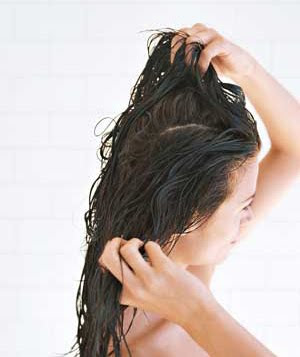
This is a quick method of drying and styling your hair. It relies on the heat released from your hands rather than the heat from a dryer. Finger drying is suitable for short to mid-length hair.
- Shampoo and condition your hair, then spray with gel and comb through.
- Run your fingers rapidly upwards and forwards, from the roots to the ends.
- Lift up the hair at the crown to get height at the roots.
- Continue lifting as the hair dries. Use your fingertips to flatten the hair at the sides.
- Finger-drying is the best way to dry damaged hair, or to encourage waves in naturally curly, short hair.
STYLING CHECKLIST
You may need :-
- Spray gel.
- Styling comb.
HAIR CARE
Good looking, shining hair is a valuable asset. It can also be a versatile fashion accessory, to be colored, curled, dressed up or smoothed down. Your hair plays a big factor in determining how you look and perceive yourself.
Proper hair care shows from the top of your head, so you want to be on top of your hair. The importance of well cared for hair can be found in the careful selection of hair-care products. Hair care requires patience along with gentle hair care products and a hair cut every few months. Hair color is a wonderful option for creating a new look for you and hair care products are becoming less harmful to your hair care.
You don't have to spend hours on your hairstyles. Here are enough home hair care tips and tricks to deal with problematic hair.
BASIC TIPS FOR DRY HAIR:
- Increase intake of low cholesterol, polyunsaturated oils such as margarine, sunflower oil, fruits and foods rich in Vitamin B.
- Eat foods rich in vitamin B, raw vegetables, pulses, whole meal bread, brown rice, liver, bananas, nuts and oily fish.
- Supplement of Vitamin E capsules will also help.
- Avoid salty and fatty cheeses.
NORMAL HAIR
Eat low fat fish, chicken, pulses like dals and sprouts.
MIXED-CONDITION HAIR
- Eat plenty of vegetables and fresh fruits.
- Avoid butter, cheese and deep fried foods.
DULL HAIR
Eat foods rich in minerals - green vegetables, nuts, lentils, whole grain cereals, shrimps, oily fish and milk.
OILY HAIR
- This condition stems from over secretion of the sebaceous glands.
- Eat lots of green leafy vegetables, salads, fresh fruits, yogurt, baked and grilled dishes.
- Avoid fried and greasy foods, milk products and red meat.
HAIR CARE TIPS
- Use a shampoo that is pH balanced and that is formulated for your hair type. Conditioner should be nourishing but not heavy. Rinse with cool water for extra shine.
- Avoid excessive blow drying and air dry hair whenever possible. This will help prevent split ends and drying.
- Massage the scalp with the oil regularly to encourage oil production.
- After swimming, wash your hair with fresh water as soon as possible to remove chlorine residue.
- Never brush wet hair, which can lead to breakage; instead, use a wide tooth comb after you shampoo and save the brush for later.